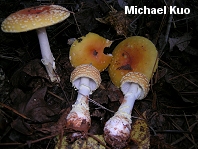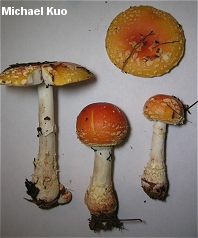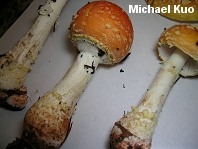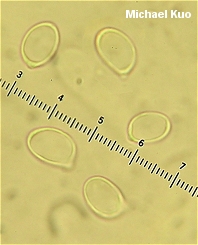| Major Groups > Gilled Mushrooms > Pale-Spored > Amanita > Amanita muscaria var. persicina |

|
Amanita muscaria var. persicina [ Basidiomycetes > Agaricales > Amanitaceae > Amanita . . . ] by Michael Kuo The cap color in this southeastern variety of Amanita muscaria is a distinctive dull reddish orange, separating it from the bright red Amanita muscaria var. flavivolvata and the yellow to orangish yellow Amanita muscaria var. guessowii. Additionally, the universal veil material adorning the stem base is usually present merely as scattered fragments and patches, rather than the well defined concentric rings and zones that characterize the other North American varieties. I have collected Amanita muscaria var. persicina only once, in a loblolly pine forest in Georgia. I was pretty thrilled with the red-bruising stem base of the mushrooms (see the admittedly awful photos), and was convinced I had discovered a "blushing" member of the muscaria complex--until I realized that it was the Georgian red clay soils that were causing the "blushing," rather than actual rubescence like that found in Amanita rubescens. The taxonomy of the Amanita muscaria species group will very likely change in the near future. A 2006 study by Geml and collaborators found DNA support for the idea that the color of the cap and warts in Amanita muscaria is not necessarily indicative of phylogenetic differences. The study used molecular dating techniques to hypothesize that "[t]he ancestral population of A. muscaria likely evolved in the Siberian-Beringian region and underwent fragmentation . . . The data suggest that these populations later evolved into species, expanded [sic] their range in North America and Eurasia" (225). As for the traditional morphological features separating "varieties," the researchers noted that among the species determined by DNA, "[a]ll . . . share at least two morphological varieties with other species, suggesting ancestral polymorphism in pileus and wart color pre-dating their speciations." Description: Ecology: Mycorrhizal with loblolly pine, Virginia pine, or eastern hemlock; growing alone, scattered, or gregariously; summer and fall; probably widely distributed in the southeastern United States; also reported from New York and New Jersey. Cap: 4-20 cm; nearly round at first, becoming convex, broadly convex, or nearly flat in age; bald; reddish orange, fading to peach colored or orange-yellow (often with a darker central area); adorned with numerous yellowish, cottony warts; sticky when fresh; the margin usually becoming slightly lined. Gills: Narrowly attached to the stem or free from it; white or faintly pinkish; close; short-gills frequent. Stem: 8-25 cm long; 1-3 cm thick; usually tapering to apex and flaring to an enlarged basal bulb; somewhat shaggy; whitish; with a fragile, whitish, skirtlike ring; with scattered patches and fragments (rarely with well defined, concentric bands or rings) of yellow universal veil material at the top of the bulb. Flesh: White throughout; unchanging when sliced, or turning slightly yellowish in the stem. Odor: Not distinctive. Spore Print: White. Microscopic Features: Spores 7-13 x 6-8.5 µ; smooth; broadly ellipsoid; inamyloid. Basidia 4-spored; basally clamped. Pileipellis an ixocutis of hyphae 2-9 µ wide. Lamellar trama bilateral; subhymenium ramose. REFERENCES: Jenkins, 1977. (Jenkins, 1986; Miller et al., 1986; Tulloss, 2013.) Herb. Kuo 10170912. This site contains no information about the edibility or toxicity of mushrooms. |
© MushroomExpert.Com |
|
Cite this page as: Kuo, M. (2013, April). Amanita muscaria var. persicina. Retrieved from the MushroomExpert.Com Web site: http://www.mushroomexpert.com/amanita_muscaria_persicina.html |



